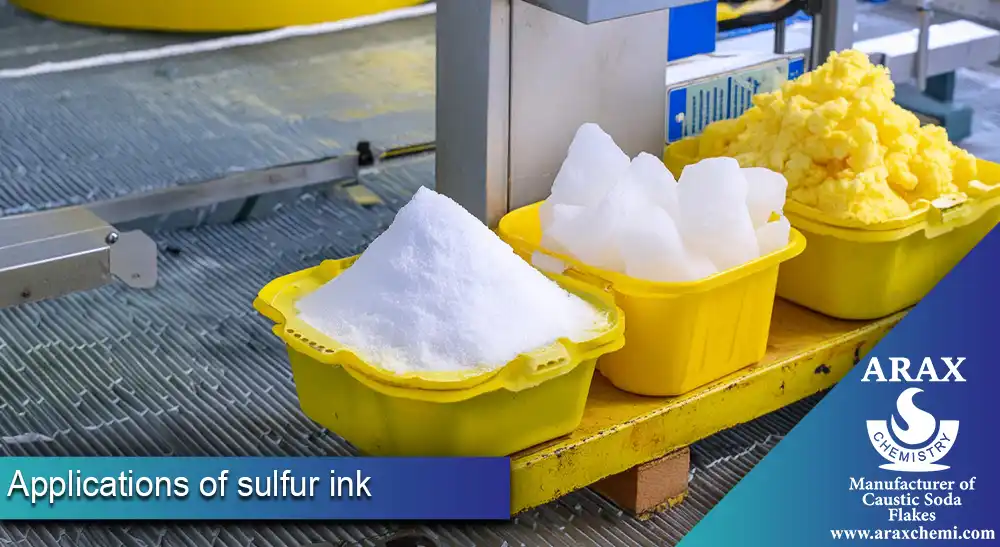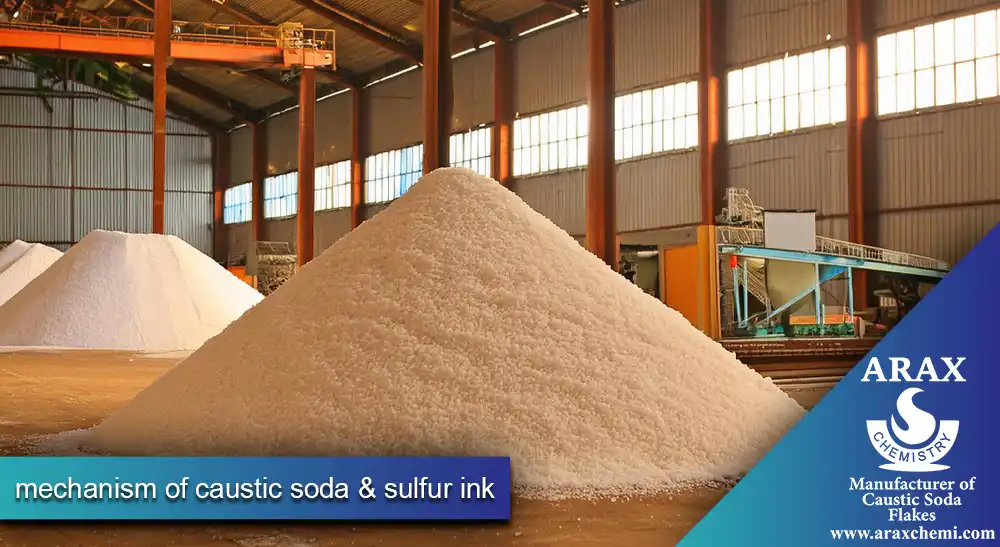The Reaction of Caustic Soda with Sulfur is one of the important reactions in industrial chemistry. This article explores this reaction, aiming to explain the mechanism of the Reaction of Caustic Soda with Sulfur, the conditions under which it occurs, and its production and applications in various industries.
What is Sulfur?
Sulfur is a chemical element with the symbol S and atomic number 16. Sulfur usually refers to the pure element (Sulfur) and is found naturally in polyatomic molecules such as S₈. It is an essential element for life, widely found in nature, and present in various compounds like sulfides and sulfates.
Main Properties of Sulfur
Color and Form
Sulfur is a yellow, crystalline solid. It also exists in liquid and gaseous states.
Chemical Properties
Sulfur burns in the presence of oxygen to produce sulfur dioxide (SO₂). It also combines with many metals and nonmetals to form compounds such as sulfides and sulfates.
Applications
Sulfur is used in the production of sulfuric acid, one of the most important industrial acids. It is also used in rubber production, fertilizers, disinfectants, the paper industry, and oil refining.
Occurrence in Nature
Sulfur can be found free near volcanoes and as compounds in minerals and deposits.
Biological Importance
Sulfur is a key element in amino acids, proteins, and vitamins, playing a crucial role in biochemical processes and metabolism.

Applications of Sulfur
Pure sulfur (sulfur) has extensive applications across various industries. Some of the key applications include:
Production of Sulfuric Acid
The largest application of sulfur is in the production of sulfuric acid. Sulfuric acid is one of the most important industrial chemicals, used in fertilizer production, oil refining, and various chemical processes.
Rubber and Plastics Industries
Sulfur is used in the vulcanization process of rubber, enhancing its durability and elasticity.
Agriculture
Sulfur is used as a fertilizer and soil conditioner. It is also employed as a natural fungicide and insecticide in organic farming.
Chemical Industries
Sulfur is used in the production of various chemicals such as sulfides, sulfates, and sulfur-containing organic compounds.
Pharmaceuticals and Health
Sulfur is used in some pharmaceutical and therapeutic products, such as antifungal and anti-acne ointments. It is also used in the production of certain antibiotics and chemotherapy drugs.
Paper Industry
In paper manufacturing, sulfur is used to produce sulfite compounds used in the pulping process.
Oil and Gas Industries
Sulfur is used in oil and gas refining to produce hydrogen sulfide (H₂S) and then pure sulfur.
Water Treatment
Some sulfur compounds are used to remove pollutants and disinfect water.
Explosives
Sulfur is a key component in gunpowder and is used in the production of explosives.
These applications demonstrate the importance of sulfur in various industries and its vital role in industrial and agricultural processes.

Mechanism of the Reaction of Caustic Soda with Sulfur
The Reaction of Caustic Soda with Sulfur occurs as follows:
3S+6NaOH⟶2Na2S+Na2SO3+3H2O3S+6NaOH⟶2Na2S+Na2SO3+3H2O

Conditions for the Reaction of Caustic Soda with Sulfur
The conditions for the Reaction of Caustic Soda with Sulfur include temperature, pressure, and raw materials. This reaction generally requires high temperatures and moderate pressures. The specific conditions also depend on the desired type and amount of product. To optimize the Reaction of Caustic Soda with Sulfur, some important conditions include:
Temperature: The temperature should be precisely controlled to achieve optimal reaction speed and efficiency.
Pressure: Appropriate pressure during the reaction plays a crucial role in controlling the reaction rate and the formation of products.
Suitable Raw Materials: The quality and quantity of sulfur and caustic soda should be considered to ensure optimal yield and efficiency.
Final Products of the Reaction of Caustic Soda with Sulfur
The Reaction of Caustic Soda with Sulfur produces sodium sulfide (Na₂S) and water (H₂O). These products have diverse applications in various industries such as oil and gas, petrochemicals, and chemical industries.
Applications
The Reaction of Caustic Soda with Sulfur is extensively used in various industries. In the oil and gas industry, sulfur is used as a pigment, and the reaction between caustic soda and sulfur can be utilized in processes such as pipe and equipment painting. In the petrochemical industry, sulfur is used as a pigment in the production of plastics and polymers, and this reaction can be employed in the manufacturing and processing of these materials. Additionally, the chemical industry may use the reaction between caustic soda and sulfur as an important chemical process in various sectors, including oil and gas, petrochemicals, and chemical manufacturing. This article explores the reaction and its applications.
Production of Basic Chemicals
The reaction between caustic soda and sulfur plays an important role in the production of basic chemicals. For example, this reaction is used in the production of sodium sulfide (Na₂S). Sodium sulfide is a crucial chemical used in the manufacture of dyes, resins, detergents, and soaps.
Polymer Production
The reaction between caustic soda and sulfur can be utilized in the polymer production process. For instance, in the production of polyvinyl chloride (PVC), this reaction is employed. In this process, sulfur reacts with sodium hydroxide and vinyl chloride to form PVC. PVC is a widely used polymer in various industries, including construction, automotive, and electronics.

Refining and Purification
The reaction between caustic soda and sulfur can be used in refining and purification processes for oil. During the desulfurization of crude oil, this reaction is employed to convert sulfur compounds into sodium sulfide (Na₂S). The sodium sulfide can then be easily separated from the oil, resulting in cleaner and less polluting oil.
Production of UV
The production of UV absorbing materials using the reaction of caustic soda (sodium hydroxide) and sulfur ink (sulfur dioxide) can be an effective approach to create materials that are able to absorb and separate ultraviolet (UV) radiation. This process can be particularly useful for applications in various industries such as clothing, packaging, and skin protection against UV rays.
Production of sulfur nanoparticles
Using different synthesis methods, it is possible to prepare sulfur nanoparticles that can act as UV absorbers.
These nanoparticles usually have special optical properties that can absorb UV rays.
Combination of sulfur nanoparticles with polymer
The produced nanoparticles can be combined with polymers such as polyethylene (PE), polypropylene (PP), or polycarbonate (PC). These compounds can be used as film, coating or base material in different products.
Applications of UV absorbing materials
Skin protection
In the production of sunscreen creams and lotions, sulfur nanoparticles can act as UV filters.
packing
These materials can be used in packaging to prevent the degradation of light-sensitive products, such as food and medicine.
Clothing
In the production of protective clothing, sulfur nanoparticles can act as UV inhibitors and protect the skin from harmful rays.
Building Materials
In the production of windows and protective glass, these materials can help reduce the penetration of UV rays into the building.
Conclusion
Ultimately, the reaction between caustic soda (sodium hydroxide) and sulfur represents one of the fascinating and complex aspects of chemistry that exists in the realm of basic materials. These reactions play a crucial role not only in laboratories but also in large-scale industries for the production of chemicals, water purification, and the processing of various products. Sulfur, due to its unique properties, has the ability to react with sodium hydroxide, resulting in the formation of new compounds such as sodium sulfide and sodium thiosulfate. These compounds, in turn, are used in many industrial processes, including paper manufacturing, oil refining, and the production of chemical products.
Understanding and precisely controlling these processes can improve the quality of final products and increase efficiency in various industries. Therefore, continuous research and innovation in these areas are essential for developing sustainable technologies and enhancing the quality of life.

